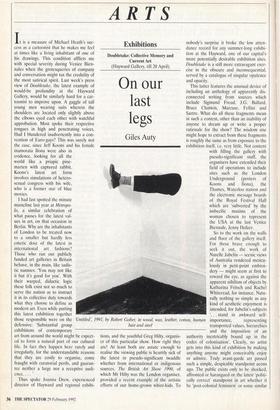ARTS
Exhibitions
Doubletake: Collective Memory and Current Art (Hayward Gallery, till 20 April)
On our last legs
Giles Auty
t is a measure of Michael Heath's suc- cess as a cartoonist that he makes me feel at tinies like a living inhabitant of one of his drawings. This condition afflicts me with special severity during Venice Bien- nales when the grotesqueries of company and conversation might tax the credulity of the most satirical spirit. Last week's press view of Doubletake, the latest example of would-be profundity at the Hayward Gallery, would be similarly hard for a car- toonist to improve upon. A gaggle of tall young men wearing suits wherein the shoulders are located ()illy slightly above the elbows eyed each other with watchful approbation. Most spoke their respective tongues in high and penetrating voices. Had I blundered inadvertently into a con- vention of Euro-gays? This was surely not the case, since Jeff Koons and his female inamorata Ilona were also in evidence, looking for all the world like a priapic pine- marten with captured rabbit.
Koons's latest art form involves simulations of hetero- sexual congress with his wife, who is a -former star of blue movies.
I had last spotted the minute musteline last year at Met,ropo- lis, a similar celebration of what passes for the latest val- ues in art, on that occasion in Berlin. Why are the inhabitants of London to be treated now to a smaller but hardly less emetic dose of the latest in international art fashions? Those who run our publicly funded art galleries in Britain behave, in the main, like sadis- tic nannies: 'You may not like it but it's good for you'. With their warped, didactic. logic these folk exist not so much to serve the nation as to instruct it in its collective' duty towards what they choose to define as modern art. Even while putting this latest exhibition together those responsible were on the defensive: 'Substantial group exhibitions of contemporary
art from around the world might he expect- ed to form a natural part of our cultural life. In fact they happen here rarely and irregularly, for the understandable reasons that they are costly to organise, come fraught with curatorial perils, and guaran- tee neither a large nor a receptive audi- ence.... '
Thus spake Joanna Drew, experienced director of Hayward and regional exhibi-
'Untitled', 1991, by Robert Gober, in wood, wax, leather, cotton, human hair and steel
tions, and the youthful Greg Hilty, organis- er of this particular show. How right they are! At least both are astute enough to realise the viewing public is heartily sick of the latest in pseudo-significant twaddle whether from international or indigenous sources. The British Art Show 1990, of which Mr Hilty was the London organiser, provided a recent example of the artistic efforts of our home-grown whizz-kids. To nobody's surprise it broke the low atten- dance record for any summer-long exhibi- tion at the Hayward, one of our capital's more potentially desirable exhibition sites. Doubletake is a still more extravagant exer- cise in the obscure and inconsequential, served by a catalogue of singular opulence and opacity.
This latter features the unusual device of including an anthology of apparently dis- connected writing from sources which include Sigmund Freud, J.G. Ballard, Bruce Chatwin, Marcuse, Fellini and Sartre. What do all these fragments mean in such a context, other than an inability of anyone to dream up or write a proper rationale for the show? The wisdom one might hope to extract from these fragments is roughly the same as from exposure to the
So to the work on the walls and floor of the gallery itself. For those brave enough to seek it out, the work of Narelle Jubelin — scenic views of Australia rendered meticu- lously in petit-point embroi- dery — might seem at first to reward the eye, as against the apparent nihilism of objects by Katharina Fritsch and Rachel Whiteread, for instance. Natu- rally nothing so simple as any kind of aesthetic enjoyment is intended, for Jubelin's subjects ... stand in awkward self-
importance, representing transported values, hierarchies and the imposition of an authority inextricably bound up in the codes of colonisation'. Clearly, no artist gets into this kind of exhibition by making anything anyone might conceivably enjoy or admire. Truly avant-garde art passed such a simple, despicable standpoint aeons ago. The public exists only to be shocked, affronted or harangued on the latest 'politi- cally correct' standpoint in 'art whether it be 'post-colonial feminism' or some similar mouthful. In short, the public must remain forever humble while the young and not- so-young artistic trail-blazers grow more and arrogant and affluent. It is not the empty pretension of the art of Philip Taaffe, Tim Rollins, Glenn Ligon, Mike Kelley and Jeff Koons which indicates, in itself, a decadent society tottering on its last legs. Rather it is our supine acceptance of the whole shebang which ought to fright- en us.



















































 Previous page
Previous page